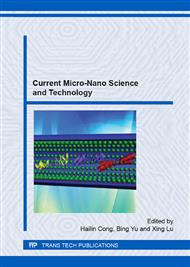p.166
p.170
p.176
p.182
p.186
p.190
p.195
p.205
p.211
Design of Temperature Signal Detection System in Electrolysis Cell of Nano-Carbon
Abstract:
Nanotechnology is one of the key technologies in twenty-first Century, in order to study the influence of the electrolyte temperature in electrolysis cell on the agglomeration of the nano-carbon, according to the principle of electrolysis in the preparation process of nano powder, the temperature detection device of electrolysis cell had been designed. Taking the AT89S52 MCU as the main controller, using six 1-wire digital temperature thermometer DS18B20 to detect the temperature signal of different six locations in electrolysis cell, then to transmit out by the wireless transmission module nRF24L01 chip, and to achieve a multi-point temperature signal collection and wireless transmission. It can realize the multi point temperature signal acquisition and wireless transmission. The multi point temperature measuring device is simple, reliable and low cost. The research results can provide some references for the preparation of nano carbon on on-line temperature measurement in electrolysis cell.
Info:
Periodical:
Pages:
186-189
Citation:
Online since:
July 2015
Authors:
Price:
Сopyright:
© 2015 Trans Tech Publications Ltd. All Rights Reserved
Share:
Citation:


